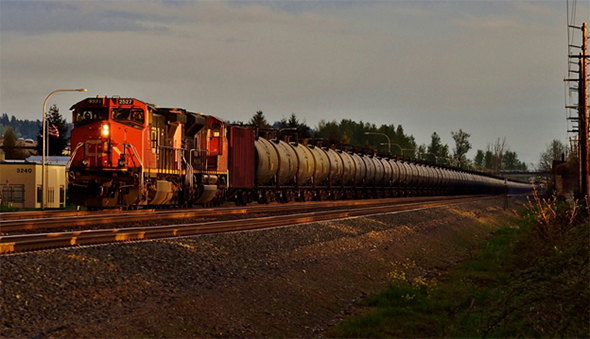
The sun was setting at 8 PM exactly on Thursday, April 20th as CN 2527 North led a train of rail tank cars carrying crude oil through Auburn, Washington. Inspecting such cars is the subject of new FRA interaction with the industry—see below. Image © 4/2017 by Nikki Burgess; all rights reserved.
Greetings everyone! Believe it or not, it’s less than a week till the new month comes in—May already—and now that everyone’s spring breaks seem to have ended, regulatory action has perked back up just a little. Let’s dive right in to the action:
PHMSA
- The agency issued a revised safety advisory governing the use of DOT-39 specification cylinders. The revised notice supersedes the advisory issued back last December (see notice 2016-14), and limits the use of such cylinders to no more than 75 cubic inches of capacity when carrying liquefied flammable gases. Given the known risks associated with cylinders that are filled with liquefied flammable compressed gases, PHMSA is issuing this revised safety advisory notice to advise offerors and transporters of DOT–39 cylinders that those with an internal volume greater than 75 in3 (1.23 L) should not be filled and/or transported with liquefied compressed cyclopropane, ethane, or ethylene, or with liquefied petroleum gases. See the new advisory here
- The agency revised the civil penalties for a knowing violation of Federal hazardous material transportation law. The Federal Civil Penalties Inflation Adjustment Act Improvements Act of 2015 required agencies to update their monetary penalties. PHMSA has elected to do the 2017 update in a final rulemaking. The maximum civil penalty for a knowing violation is now $78,376, except for violations that result in death, serious illness, or severe injury to any person or substantial destruction of property, for which the maximum civil penalty is $182,877. In addition, the minimum civil penalty amount for a violation relating to training is now $471. The new levels are effective as of April 19, 2017. See the penalty schedule here
- The agency announced its intent to renew ICR’s for no less than eleven subjects of interest to its mission, including things like security plans, pressure receptacles, cargo tank vehicles, testing non-bulk packages, and other relevant items. Will these ICR’s affect you? Find out here
OSHA
The nation’s safety agency also brought forward a set of ICR’s, these delaing with hazard reporting by employees, fire extinguisher maintenance (don’t forget there are potential hazmat—good ol’ UN 1044!), and rigging equipment (like slings, hoists, and chains) used in material handling. See the three ICR’s respectively at the provided links:
- https://www.gpo.gov/fdsys/pkg/FR-2017-04-24/pdf/2017-08228.pdf
- https://www.gpo.gov/fdsys/pkg/FR-2017-04-24/pdf/2017-08229.pdf
- https://www.gpo.gov/fdsys/pkg/FR-2017-04-24/pdf/2017-08226.pdf
FAA
The agency will host its third meeting regarding the use of drones—a burgeoning piece of equipment in the transport industry. Will they be allowed to carry hazmat someday? Time will tell, but if you want your skin in the game, here’s the portal
FRA
American Railcar Industries (ARI) is contesting the ICR issued by the agency in respect to the number of hours it claimed would be necessary for the railcar industry to comply with the new safety inspection directives associated with rail tank cars carrying hazardous materials. The total time required as outlined by the FRA (about 69,000 hours across the industry) is at no small odds with the total time estimated by ARI (about 176,000 hours across the industry) to take the same action. At issue—costs and practicality. ARI is pursuing legal action in the matter as well, that regarding FRA’s authority to issue such an ICR in the first place. If you ship bulk liquids, or own, lease, or ship via rail tank cars, you just may want to check this out
Labelmaster is a full service provider of products and services for the Hazardous Materials and Dangerous Goods professional, shippers, transport operators, and EH&S providers. See our full line of solutions at www.labelmaster.com.


